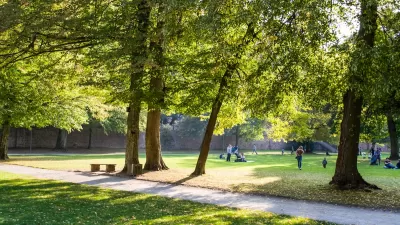Yet another climate change side effect: more frequent urban heat waves. And because urban temperatures tend higher than rural ones, cities should be ready to protect the most vulnerable.

Rob McDonald of the Nature Conservancy shares his thoughts on an evolving threat. "I was struck by how frequently big cities get hit by a bad heat wave: from Chicago in 1995 to Moscow in 2010 to London today. While for any particular city bad heat waves occur only infrequently, there are several cities globally facing one every summer."
Causalities were especially high during the European heat wave of 2003. "In France, the most impacted country, there were 11,000 deaths. The total for all Europe was greater than 70,000 dead. [...] The event produced "so many bodies that the morgues were full, requiring other refrigerators in a vegetable market to be commandeered."
The trend toward severe weather, says McDonald, can be attributed to climate change. "[...] these kind of extreme heat waves will become more common. One study for the U.S. predicted a four-fold increase in the number of days with extreme heat by 2050."
McDonald suggests ways cities can mitigate the danger. These include emergency cooling centers located near those at risk (such as the elderly) as well as more urban green space. He writes, "by providing shade the trees reduced the 'urban heat island' effect, the tendency for cities to be generally hotter than the surrounding countryside [...] trees and other vegetation also cool the air in cities because they transpire water into the atmosphere," storing excess heat away from ground level.
FULL STORY: Hot Times, Summer in the City: Understanding the Urban Heat Wave

Planetizen Federal Action Tracker
A weekly monitor of how Trump’s orders and actions are impacting planners and planning in America.

Chicago’s Ghost Rails
Just beneath the surface of the modern city lie the remnants of its expansive early 20th-century streetcar system.

San Antonio and Austin are Fusing Into one Massive Megaregion
The region spanning the two central Texas cities is growing fast, posing challenges for local infrastructure and water supplies.

Since Zion's Shuttles Went Electric “The Smog is Gone”
Visitors to Zion National Park can enjoy the canyon via the nation’s first fully electric park shuttle system.

Trump Distributing DOT Safety Funds at 1/10 Rate of Biden
Funds for Safe Streets and other transportation safety and equity programs are being held up by administrative reviews and conflicts with the Trump administration’s priorities.

German Cities Subsidize Taxis for Women Amid Wave of Violence
Free or low-cost taxi rides can help women navigate cities more safely, but critics say the programs don't address the root causes of violence against women.
Urban Design for Planners 1: Software Tools
This six-course series explores essential urban design concepts using open source software and equips planners with the tools they need to participate fully in the urban design process.
Planning for Universal Design
Learn the tools for implementing Universal Design in planning regulations.
planning NEXT
Appalachian Highlands Housing Partners
Mpact (founded as Rail~Volution)
City of Camden Redevelopment Agency
City of Astoria
City of Portland
City of Laramie





























